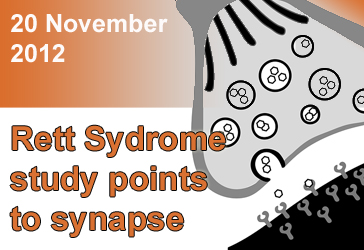Check out other stories from the Latest News
Rett Syndrome-Linked Gene Needed for Synapse Stability
By Shana R. Spindler, Ph.D. on October 4, 2012

Background: Rett syndrome (RTT) is a genetic disorder marked by developmental regression after 6 to 18 months of age. RTT, which is almost exclusively seen in girls, is currently classified as an Autism Spectrum Disorder (ASD). Most RTT cases are caused by mutations in the MECP2 gene. Some atypical forms of RTT do exist, including those caused by variations in the CDKL5 gene. Both MECP2 and CDKL5 contribute to neuron maturation, but exactly how CDKL5 is linked to RTT symptoms is unclear.
What’s New: Researchers have uncovered a series of events that indicate an important role for CDKL5 in the stability of synapses, sites where two neurons meet to transmit electric or chemical signals. According to a new study published in the September 2012 issue of Nature Cell Biology, CDKL5 is important for the density and shape of dendritic spines, small protrusions on a neuron that harbor a synapse and receive neural signals.
Why it’s important: Studies like this help piece together how variations in different genes can lead to the same syndrome. As doctors and researchers work to develop targeted therapies for disorders within the autism spectrum, it will be important to understand how each individual’s genetic variations affect the development and function of his or her brain.
Help me understand :
| Source(s) : |
| Tweet |

